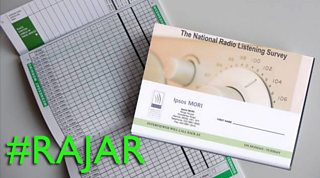
Editor's note: on the eve of the publication of the latest radio listening figures, Paul Kennedy, Research Director at RAJAR, explains how they're gathered - SB.
, or 'Radio Joint Audience Research', is the official body in charge of radio audience measurement for the UK. RAJAR was established in 1992 to replace two other measurement systems operated separately by the 主播大秀 and Commercial Radio. Today RAJAR collects information on behalf of over 300 stations, ranging from very small local services to the national networks.
Each week interviewers from (an audience research organisation) recruit over 2,000 people to complete a RAJAR diary. These people are chosen at random within carefully selected areas to ensure the survey is completely representative in terms of the type of people who participate and the areas where they live. The random selection process also ensures inclusivity as much as possible - non-listeners are recruited, while people with disabilities are encouraged to take part with the help of a family member or carer if necessary. Ethnicity is also carefully monitored, with specific quotas set in areas of disproportionate ethnic balance to maintain the correct representation. Recruitment usually takes place over the weekend, and on the following Monday the selected respondents begin keeping a diary of their week's listening.
RAJAR uses a paper diary because it is the system that works best for most people. However, RAJAR is testing an online version, and this could be introduced later in 2011. But it is seen as a complement to the paper diary and not a replacement for it because there are many people who still do not have online access. The diary has separate pages for each day, with the day divided into quarter-hour periods down the side of the page, and the respondent's selected stations across the top to form a matrix. The respondent simply has to draw a line from the quarter-hour when they start listening to a station until the time when they stop. In addition to the station and date/time, the diary also collects information on where the listening takes place (e.g. at home, or in the car) and the platform (e.g. AM/FM, DAB, Internet).
At the end of the week, the interviewers collect the diaries and return them to Ipsos-MORI for processing. This is repeated weekly and, at the end of every 3-month period, the numbers are aggregated to produce results for each station. All stations use the information to plan programme schedules, while the commercial stations also use the statistics to sell advertising airtime, without which they would cease to exist.
More than 100,000 people participate in the RAJAR survey every year, making it one of the largest media studies in the world. The paper diary is the most common method of measuring radio audiences worldwide, although some countries use electronic devices called audiometers. RAJAR has tested several audiometers and continues to work with developers to find one at an affordable price that measures all stations equally, regardless of size, format or means of broadcasting.
Paul Kennedy is Research Director at RAJAR
- The Rajars for Q4 of 2010 are published on Thursday morning. We'll publish details here on the blog.
